- Black Tomato Varieties Guide: Everything You Need To Know About Them - June 19, 2022
- How to Find the Best Cultivator - December 27, 2021
Black tomatoes? Are they genuine? Believe me. These were my exact words until I learned about them. And once I discovered them, I was captivated by their color and uniqueness. If you, like me, had no idea about black tomatoes before, don’t worry, I’ve got you.
Black tomatoes are an interesting variation on red tomatoes or any other type of tomato. The outer skin of a black tomato is dark maroon, but when exposed to enough sunlight, it turns black. These are equally as lovely as the others. Consumer feedback indicates that the flavor is intense, sweet with a hint of sourness – exceptional.
My goal is to provide you with enough information about black tomatoes, including where to buy them and how to grow and care for them. There are numerous black tomato varieties to choose from. If you’re a home gardener, I’m sure you’d be interested in learning more about all of these.
Bottom Line Up Front
There are many different types of black tomatoes, but my personal favorite is the Black Krim tomatoes. It has the best flavor, with the perfect balance of salt, sweetness, and acidity. Furthermore, it is simple to grow and requires little maintenance.
This article contains a general guide to black tomato varieties, which I recommend you read in its entirety. If you don’t have enough time, the bullets below will help you understand the article’s overview.
- Black tomatoes are safe to eat and are rich in antioxidants called anthocyanin.
- They are summer-loving plants and hence require 6-8 hours of full sunlight.
- They are low-maintenance but may require staking if grown heavy.
- They need well-aerated soil with a slightly acidic pH
What are Black Tomatoes?
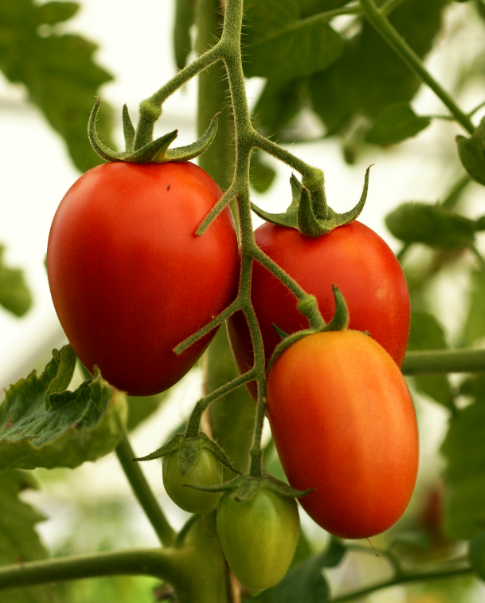
The black tomato, scientifically termed Solanum Lycopersicum, is a genetically engineered tomato that originated in Russia. Because of their black color, the majority of people wonder if they are safe to eat. Well, the answer is yes. They are as healthy as the regular ones.
Why are those tomatoes black then? What is the reason behind the color? – The dark pigment in any fruit increases with an increase in the compound anthocyanin. Not only is it on black tomatoes but also blueberries, blackberries, red raspberries, eggplants, and black grapes.
The color of the flesh makes the black tomatoes more interesting. Some varieties have dark purple-colored flesh, while others have normal (red-colored) flesh.
Initially, black tomatoes were only found in a limited geographic area. People began to experiment with the fruit’s flavor as time went on. Its rarity in terms of appearance and flavor prompted higher expectations than usual. Black tomatoes are now commonly used in salads, sandwiches, and sauces.
If you enjoy cooking, you might enjoy experimenting with its flavors. With just a drizzle of oil, a pinch of salt, and some basil toppings, you’re ready to go. You can also eat a fresh raw black tomato.
One disadvantage of black tomatoes is their perishability, which means they have a shorter shelf life. Canning is the method I prefer for preserving the flavor so that you can enjoy it for a long time. It’s just like other tomato varieties.
Popular Varieties and Types
Now that the spotlight is on black tomatoes, people want to learn more about their bold, rich flavor and superior meaty texture.
There are over 50 varieties of black tomatoes. I’ll only talk about the most common ones so you can compare them. I’ll also try to include appropriate planting zones for each variety so you can find the best match for your garden.
Black Beauty Tomato
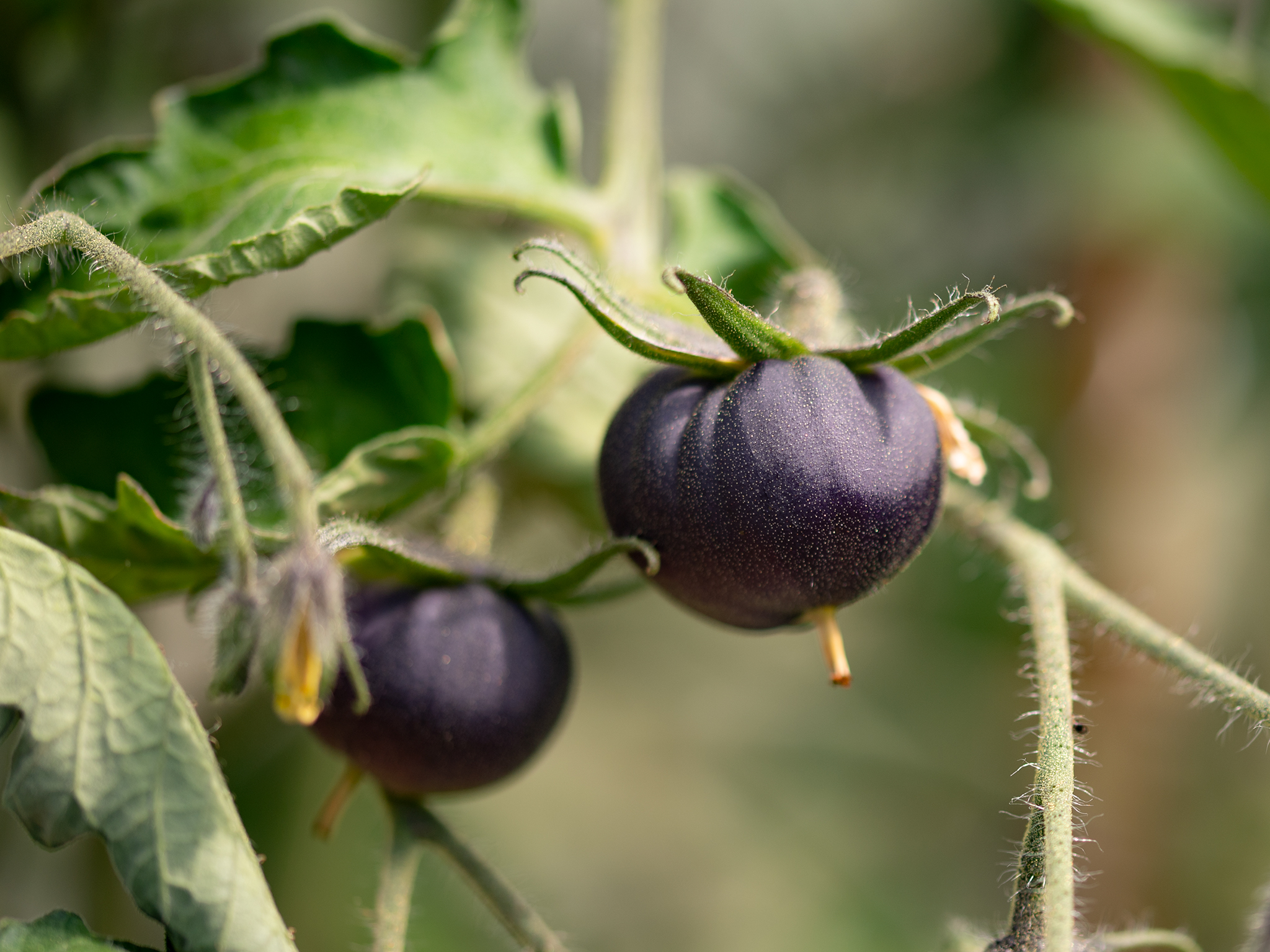
Black Beauty tomatoes are a cross between beefsteak (thick fleshed) varieties and black (deep-purple) fleshed varieties. It is regarded as one of the best-tasting tomatoes. Its earthy tones are rich, smooth, and savory.
It’s the darkest tomato variety I’ve ever seen. I adore how the color develops from little tiny berries to when they are ready to harvest. If you want this black, shiny, and beautiful tomato in your garden, make sure it gets plenty of sunlight.
If you cut open a Black Beauty Tomato, you’ll be greeted with a lovely red flesh. The arrangements are stunning, especially with the seeds interspersed among the flesh. I’m sure you’ll enjoy the meaty and juicy flavor of Black Beauty in your salad.
Because it is not frost-hardy, this type should be planted in zones 10a to 10b. The normal height is three to four feet, and it clings to the vine effectively. The taproot system is why you should plant them deep in Black Beauty.
Black Krim Tomatoes
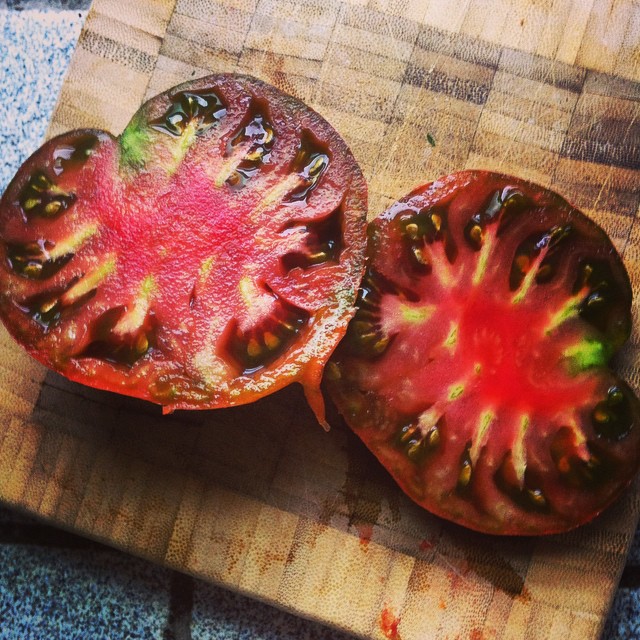
The Black Krim tomatoes have a brief backstory. It is said that at the end of the Crimean War, soldiers returned home with Black Krim tomato seeds, which were then passed down through generations.
Black Krim tomatoes are beautiful heirloom tomatoes with dark maroon color and green shoulders. Black Krim is rich in flavors. It tastes sweet but also salty with balanced acidity. You can just put a little salt on it and enjoy the whole thing.
This indeterminate variety favors multiple harvesting. Ripening starts in August and continues for several weeks, so you can enjoy these for quite a long time. The fruit is large, so you wanna set some trellis or stakes.
Like Black Beauty, Black Krim is vulnerable under frost conditions. People living in planting zones 10 and 11 can grow them very well. It’s believed to cope well under a wide range of climates. They have been grown in zones 7 and 6 as well. However, this might affect the size of the fruit.
Cherokee Purple
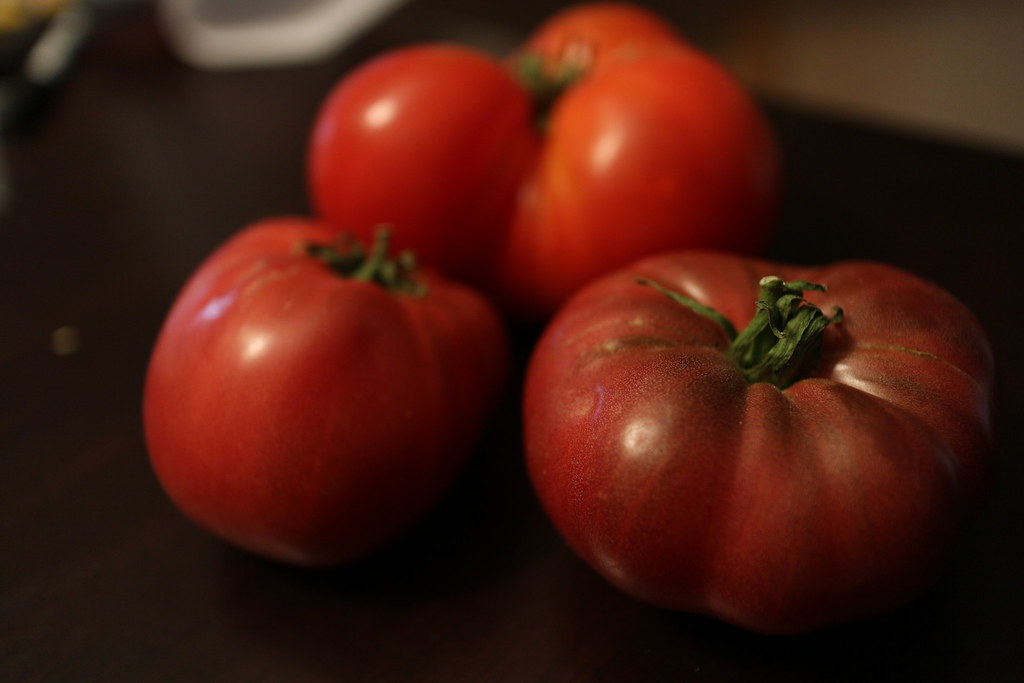
Like Black Beauty and Black Krim, Cherokee Purple was also well saved for generations. A man named Craig LeHoullier is to thank for the popularity of this tomato. He is a tomato expert. In an interview, he says that a man named John D Green sent him these seeds as a gift.
Le Houllier grew the seeds, harvested them, and tasted them. The name, Cherokee Purple, is based on the fact that it came from Cherokee Indians and it’s purple. He then saved the seeds and distributed them to the seed company.
Coming back to Cherokee Purple, it is also an indeterminate heirloom variety with purple hues. The bulbous fruit is rich, complex, sweet, and has a juicy texture and smoky flavor. Cherokee purple comes second on my list of favorite black tomato varieties. It just melts in the mouth.
The fruits are gigantic, gnarly, and fit well in your hand. The flesh has a dramatic marble rosy red on the inside and green on the outside – very interesting. The flavor is perfect, one of the reasons why it’s been preserved for all these years. The sweetness comes first, and once your palate adjusts, the acid begins to take its course.
The coloration goes red to green on top to almost purple underneath. Plants are compact, unlike other aggressive heirloom varieties, highly productive, and continue to ripen throughout the season.
Paul Robeson Tomato

For people who praise novelty, black tomatoes are a real blessing. We’re noticing that the black tomatoes are dominating the regular heirlooms. In an extensive panoply of newness comes another variety that has gained popularity in recent years.
Named in honor of Paul Robeson, this variety is an indeterminate heirloom variety. I like the shade dusky, brick red with green shoulders. I think they look great with crimson red flesh. It’ll add flavor to your salad with a smoky, sweet taste and a hint of tanginess.
These are perfect for slicing as the size reaches 3 to 4 inches in diameter and 7 to 10 ounces in weight. It is an early maturing one (65 days after germination).
Black Prince Tomato
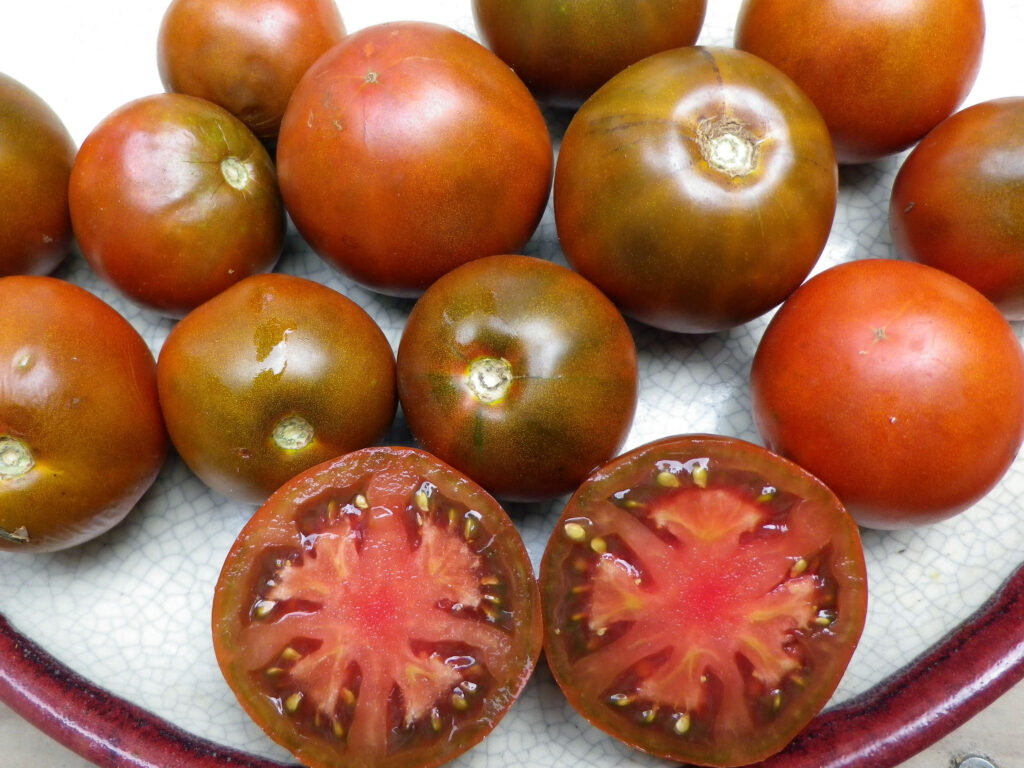
This tomato variety is getting noticed because of its dark chocolate brown color. It gives you nice juicy, rich flavors. I like how it gives the best result even in cold climates. The fruit arrangements in clusters are one of the things that fascinate me about tomatoes. In that regard, Black Prince Tomato is nothing new. Beautiful fruit in clusters will be delivered to you in August.
Black Prince Tomatoes have a lot of side shoots, so make sure you prune them regularly. Another downside to this variety is that you’ll see some fruit cracking at the time of harvesting.
Carbon Tomatoes
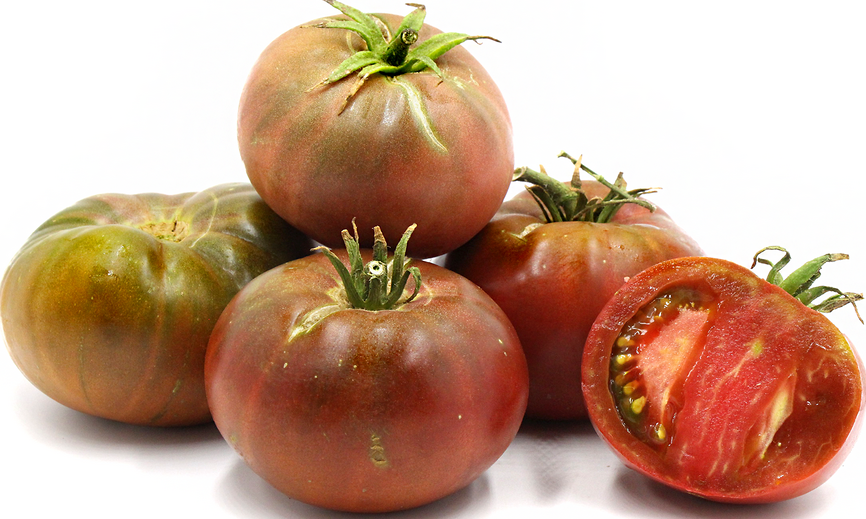
One of the blackest tomatoes, I bring you Carbon tomatoes. This performs pretty well in the garden. I like the way it grows — it’s not that tall. You don’t need to worry much about the trellis and staking. It’s got a decent amount of foliage and doesn’t trouble much to their companions.
These are perfect in flavor and add more color to your plate. This heirloom beefsteak fruits mature about 80 days after germination. With proper care and maintenance, the size reaches 8 to 12 ounces.
Chocolate Amazon
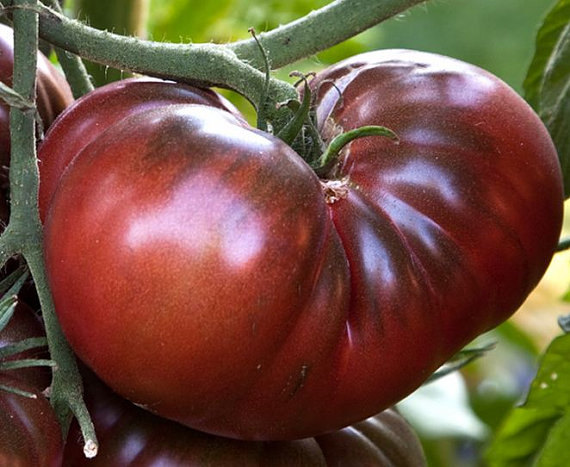
As the name implies, Chocolate Amazon tomatoes are chocolatey-colored tomatoes. They change in color from green to brown during maturity. They mature at about 80 days.
Chocolate Amazon has dark, heavy, and earthy flavors. Unlike any other warm-climate tomatoes, it continues to provide fruit in the fall. It’s an indeterminate beefsteak tomato that reaches a height of 6 to 8 feet. Spacing for this plant is similar to others.
Black Tomatoes Soil Requirements
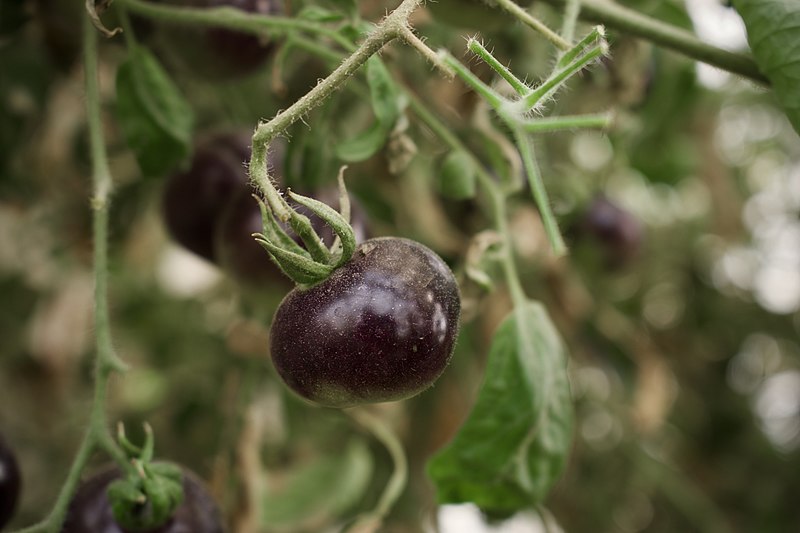
Tomatoes flourish in warm soil. The idea is to plant them in areas where there is less chance of water stagnation. The tomato is an acid-loving plant that prefers a slightly low pH of 6 to 6.8. When it comes to flesh color, pH is a complete game-changer. In acidic soil, the color remains red, while in alkaline soil, it changes to a blue-purple shade.
One of the reasons your plant isn’t performing as well as it should is a lack of essential micronutrients. The pH of the soil influences the availability of soil micronutrients. So, just make sure you check the soil’s acidity level.
There are methods for adjusting the pH of the soil. Composts, sphagnum peat moss, sulfur, or chelated fertilizer are effective at lowering pH. Compost, limestone, and wood ashes can also be used to reduce soil acidity (increase pH).
Black Tomatoes Light Requirements
Black tomatoes are all about color and individuality. Sunrays influence the skin tones of black tomatoes. The majority of the varieties are not frost-hardy, which means they cannot withstand frost. A black tomato requires 6 to 8 hours of direct sunlight per day.
Black Tomatoes Water Requirements
Because tomato roots are deep, they seek water. A newly planted one will only need to be watered once per day. Watering frequency gradually increases as the plant grows. When the plants are in the ground, make sure they are watered twice a day. Water container plants until the water runs out of the drainage hole.
According to what we know, tomatoes require 1-1.5 inches of water per square foot of soil. Plants begin to show symptoms when not given enough water. Wilting is a common symptom of both underwatering and overwatering. In such cases, it is prudent to investigate the soil and leaves. If the leaves are dehydrated, they are dry and crisp. Similarly, they feel soft when overwatered.
Root rot is another problem when it comes to overwatering. The impromptu rescue for overwatering is shifting the plant to a sunny spot with good aeration. Morning is the best time to water your black tomatoes. This is because the leaves remain turgid till the time it reaches their peak hour. If the top 3 inches of the soil is dry, give them a nice drink. If it’s damp, let them be.
Best Black Tomatoes Companion Plantings
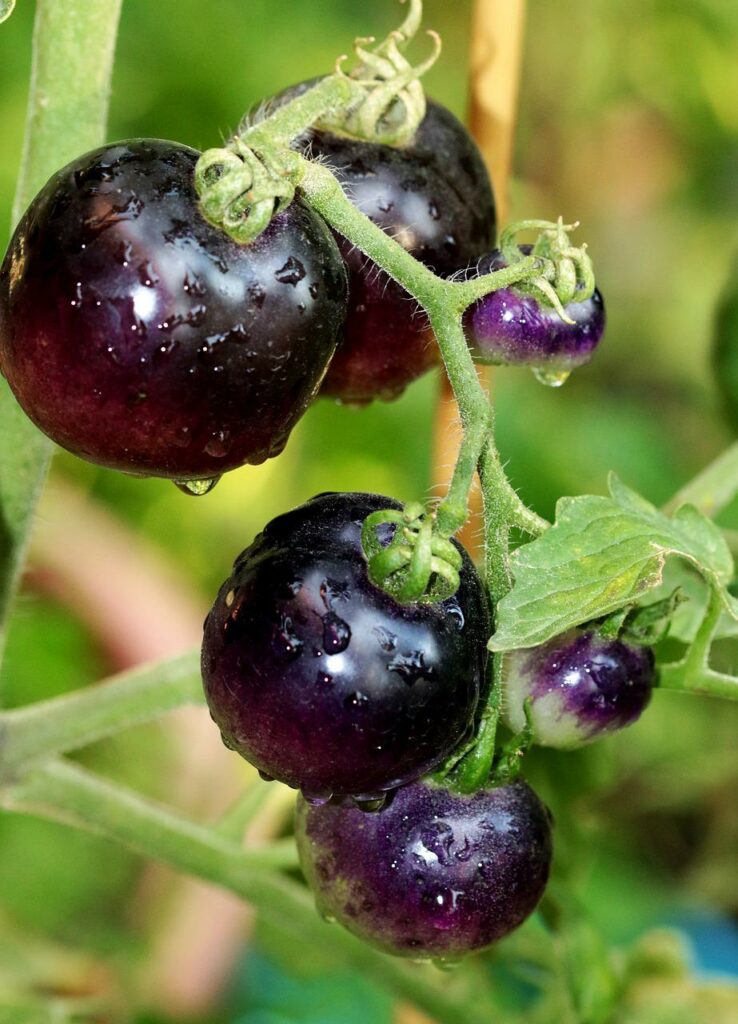
Companion plants are planted near the primary crops so that they can benefit from one another. These plants should not be heavy feeders as they can compete for nutrients with the primary crop. Gardening with companion plants is always a smart idea. It not only provides you with a variety of vegetables, but it also protects the plant from pests. Some of the plants also attract beneficial insects that help with pollination.
If you enjoy gardening, I’m sure you’ll appreciate adding some companion plants to your primary crop. Here are a few of the best companion plants that come to mind:
- Marigold
- Basil
- Beans
- Peas
- Carrots
- Onion
- Garlic
- Amaranth
- Asparagus
- Lettuce
Black Tomatoes Disease and Common Problems
Despite continuous care, plants aren’t immune to diseases and disorders. As a gardener, you must be able to take all the risks along with the privilege.
Common Problems
Blossom-End Rot
Blossom-End rot is the most common problem in tomatoes. You’ll see a dry, leathery, dark brown area at the bottom of the fruit hence the name. Since it’s not caused by any pathogens, it’s a physiological problem. The major reason for this physiological disorder is the lack of adequate calcium in fruits. However, drought plays a supportive role. So, don’t let the plants wilt. Mulching can be one of the best solutions.
Fruit Cracking
The fruit cracks occur in two fashions- radial and concentric. Again, the reason for this disorder is the same – not enough watering.
Catfacing
Catfacing is a condition where the fruit undergoes a malformed or irregular shape. In severe cases, the seed cavity is visible from the outside. It’s caused due to a cool temperature at the early growth stage. The solutions to this problem are to plant late, use resistant varieties, and use plastic tunnels to increase the temperature.
Diseases
Early Blight
This is a common fungal disease caused by the pathogen Alternaria solani. The plant will show symptoms like brown lesions with a yellow halo. Alternaria is a soilborne pathogen that will overwinter in the soil even in cold climates. The curative measure for this disease is to use copper fungicides, resistant varieties, crop rotation, sanitation, staking, and mulching.
Bacterial Spot

Bacterial spot (Xanthomonas spp) is a bacterial disease favored by warm temperatures. The pathogen is present on the seed or maybe wind-driven. The visible symptom of the bacterial spot is a round, brown lesion on the fruit. Lesions on leaves are with a shot-hole appearance.
For management, we can use pathogen-free seeds. Seed treatment, cultural practices, and crop rotation are other options.
Bacterial Wilt
Bacterial wilt is another dangerous disease of black tomato. This bacterial disease can survive long in the soil even without susceptible hosts. High soil temperature and high moisture favor this disease.
Plants wilt rapidly. The wilted portion, when cut, is darker and water-soaked. The easiest method to diagnose this disease is by keeping the cutting in water. If it excretes a white ooze, it’s confirmed that the plant is infected. Its management includes clean planting materials, resistance varieties, and crop rotation.
Buckeye rot
High humidity and warm temperature favor the Buckeye rot in tomatoes. The visible symptoms of this disease are brown, oily-looking lesions on the fruit. As the fruit enlarges, concentric rings develop on the lesions. Its management includes mulching, crop rotations, and the application of fungicides.
Late Blight
The seed-borne pathogen (Phytophthora infestans) is responsible for the development of this disease. In this case, moist weather, cool night temperatures, and warm daytime temperature are the one that favors the late blight in tomato.
Leaves have brown water-soaked lesions. Gradually, the lesions spread all over the leaves. The distribution of lesions now reaches the fruits and finally withers them.
Where To Purchase Black Tomatoes?

Growing your black tomatoes is always preferable to buying them online or at a nearby market. Tomatoes’ perishable nature prevents them from remaining healthy for an extended period. Here is a list of online stores that sell black tomato seeds or fruit:
- Reimer Seeds
- Amazon
- Etsy
- Rareseeds.com
- Seed Savers
- Home Depot
Conclusion
I hope you had as much fun reading this post as I did writing it. The Black Krim Tomatoes are my particular favorite. It’s a popular variety with a delicious, deep flavor. Tomatoes are known for their tanginess and acidity, and this variety has both. You can save the seeds yourself because it is an heirloom variety. This variety’s indeterminate growth habit adds to the list of reasons why we should plant them.
This is a good place to start if you want to grow your black tomato. Let’s go digging in the dirt for some Black Beauty, Black Krim, or Cherokee Purple.

